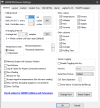I'm trying to set-up alerts in HWinfo64 (Windows 10) to track GPU temperature and Core load. I want to delay once the alert threshold is reached. For example if GPU temperature reaches above 50C, I want to wait for 4 mins to see if the system can self correct to lower the temperature to 47C, if it doesn't/cannot, then I want to trigger the alert. I tried the following settings but I get an alert immediately when the GPU temperature reaches the threshold.
If Value >= 50
Notification distance = 240 seconds
Number of samples to trigger alarm = 2
Please help
If Value >= 50
Notification distance = 240 seconds
Number of samples to trigger alarm = 2
Please help

